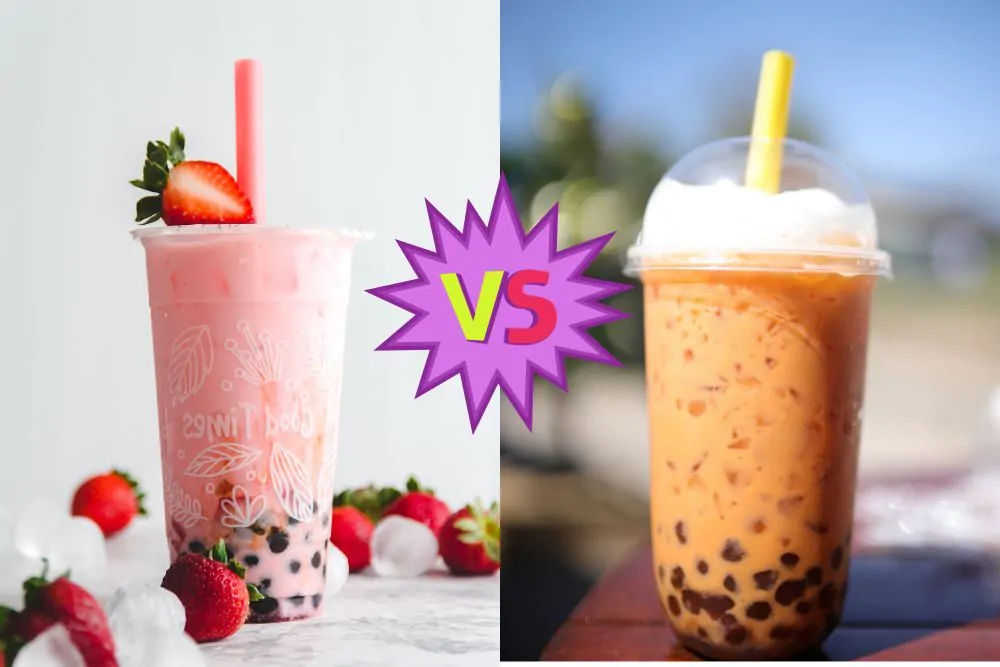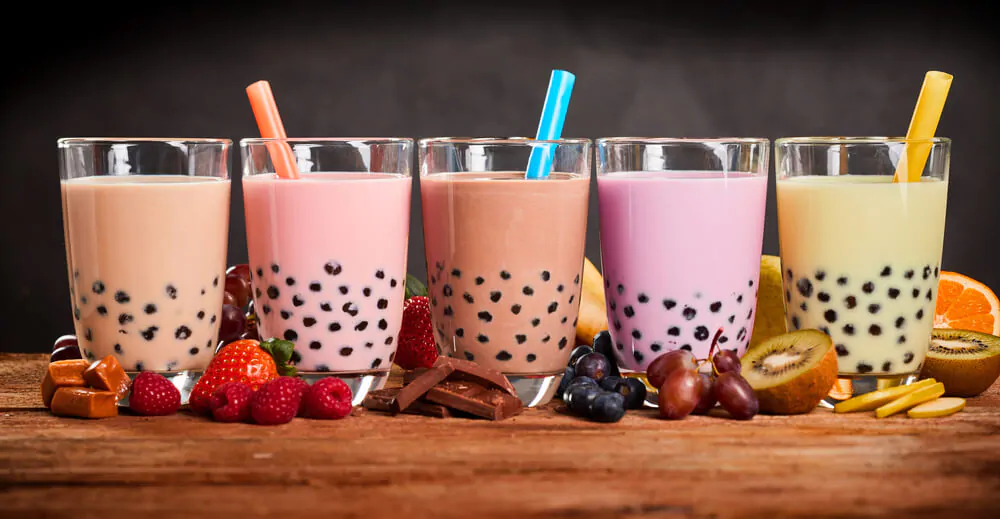Our boba tea vs bubble tea explainer will help you understand why these terms are used interchangeably in cafés, so you can order your drink with confidence.

There’s nothing quite like having a sweet, tasty, milky drink… to chew on! That’s why I love bubble tea. I first had one of these tantalizing cold beverages at a restaurant, and upon noisily slurping the giant tapioca balls up through a big fat straw, I was instantly hooked.
It was, I soon realized, more like dessert than just a drink. I have since discovered a local café dedicated entirely to bubble tea; the menu is daunting at first, and the flavor options are almost endless. Bubble tea is a bit like a milkshake in that it can be as simple or as decadent as you choose, and it can be pretty much any flavor.
I recently heard the name boba tea and wondered if it was different to bubble tea. It turns out that the names are used interchangeably as these are the same thing.
Other Names For Bubble Tea
Aside from boba, you might rarely see it spelled as booba tea. There are other names for the same drink, including pearl tea, pearl milk tea, and tapioca tea. Let’s dig a little deeper into the linguistics of bubble tea.
Whether you call it boba, booba tea, or bubble tea seems to be a matter of geography. In Taiwan, where the drink originated, and elsewhere in Asia, it’s called boba. However, in Japan, it is often called tapioca drink or tapioca.
In Canada and the UK, I’ve generally heard it called bubble tea. In the US, it tends to be called bubble tea in the East and boba in the West. The term boba can refer to a wide range of chewy drinks or tapioca pearls or balls that lurk at the bottom of the beverage.
The balls are typically marble-sized and caramelized. Some say the bubble in bubble tea refers to the bubbles at the top of the drink rather than the tapioca balls.
The Spread Of Boba Tea

Bubble tea was first created in Taiwan in the early 80s. Within the next decade, it became popular in Hong Kong and Japan, and later the rest of the world took an interest.
There are conflicting stories about which tea room first invented bubble tea. What does seem clear is that the original recipe was a concoction of Taiwanese black tea, tapioca pearls, condensed milk, and syrup or honey. Today, the choices for tea, pearls, and milk are almost endless.
These days, boba tea is the drink of choice in Taiwan and worldwide. You can find independent bubble tea shops in cities around the world or big chains like Sharetea and Chatime.
Why Is Bubble Tea So Popular?
One of the main reasons bubble tea is so popular is because it’s delicious. While coffee and tea are classics, bubble tea feels like a real treat since it’s so different, and you can’t find it in just about any coffee shop. The scarcity makes people feel like they can’t pass up on the opportunity.
It’s also versatile. At first, you might think boba tea is a gimmick and the fad would die down, but since there are endless drink combinations, it would take a very long time for fans to run out of options and get bored.
Although looks aren’t everything, they are a contributing factor. Who hasn’t seen a picture of boba tea on Instagram? Especially if the tea shop sells its drinks in cute or quirky cups.
Bubble Tea Ingredients

In its most basic form, bubble tea consists of black tea, milk, tapioca pearls, and ice, shaken together and served with a fat straw. There are also some additional ingredients like rainbow jelly, fruit, and even pudding that can be added to your drink.
1. Tea
Most bubble teas are made with black, green, or oolong tea. Black tea, especially Earl Grey, is the most popular choice. Green tea is another option. Jasmine green tea and matcha powder are popular among those looking for healthier options.
Tea-free variations include snow ice (a powdered coffee-based, frozen blended drink), cream-based drinks, and fruit-based drinks. You can also find herbal teas in some shops.
2. Milk
Milk and milk alternatives are often added to give bubble tea its creamy texture and flavor. In addition to fresh milk, options can include condensed milk, ice cream, almond milk, coconut milk, soy milk, or non-dairy creamer.
Some sour fruit-flavored bubble tea drinks are prepared without milk because the acidity of the fruit syrup can curdle the milk.
Bubble tea can also be served hot or cold, whether you request your drink with milk or not. The best thing about this is that you can enjoy bubble tea all year round. With that said, if your tea is too hot, the bubbles might melt, so many bubble tea fans will ask for it warm instead.
3. Tapioca Pearls
Many toppings (which, ironically, often sink to the bottom) are added to teas to make them all the more interesting. Traditionally, you might have noticed boba tea is usually made with black pearls. These are tapioca pearls.
The tapioca is derived from the cassava root. These pearls are sweet and chewy. They’re often dunked in brown sugar for extra sweetness and flavor.
4. Flavored & Fruit Pearls
You’re not just limited to tapioca pearls. The bubbles come in all kinds of quirky flavors, including sea salt, cheese, lychee, quinoa, chocolate, jujube, and even Sichuan pepper. With that said, many people prefer to stick to fruit flavors.
Rainbow boba is also popular. Rainbow boba is usually all one flavor – coconut – but is popular because each bubble is a different color, creating a rainbow effect.
5. Popping Boba
Boba tea is not always chewy. Sometimes the bubbles release a burst of flavor in your mouth. This is called popping boba.
Popping boba comes in all different colors and flavors. More often than not, people stick to fruit.
6. Fruit
Aside from bubbles, you can even have fruit in your bubble tea. For example, aloe vera cubes, watermelon cubes, coconut, or passion fruit seeds. You might even come across dried or candied pineapple, papaya, or mango.
7. Pudding
Some boba tea even comes with pudding! This usually has a soft consistency and adds a creamy, custard-like flavor.
This kind of pudding is made from eggs, cream, sugar, and gelatin. Some people might skip the bubbles and go right for pudding milk tea, while others like to have a layer of boba at the bottom of their drink, followed by tea, and topped with the pudding.
8. Coffee Jelly
If coffee lovers are feeling skeptical of bubble tea, this might change your mind – you can ask for coffee jelly. It’s what it sounds like; coffee-flavored jelly to give your boba a boost.
Bubble Tea Variations
Bubble tea is often sweetened with syrup. Sometimes alternative sweeteners are used, such as organic honey, agave nectar, or stevia.
For a sweeter version of this fun and fancy beverage, try brown sugar boba tea. For an unusual purple color and earthy, coconut-like flavor, try taro bubble tea.
Taro is a root vegetable similar to a sweet potato, so it also acts as a thickener. There are also fresh fruit-based boba drinks. Popular flavors include mango, lychee, lemon, and tomato.
Bubble tea is usually served cold, but there are some hot options, including Hong Kong Milk Tea and Yuanyang, which is Hong King Milk Tea and coffee.
Milk smoothies are basically bubble tea minus the tea. Snow Bubble is a bubble tea without tea too. They are typically made with blended ice, non-dairy creamer, flavors, and boba.
There are various bubble tea smoothies and milkshakes available. Bubble coffee or Snow Ice is made with blended ice, powdered coffee, and added flavor. You can also have decaf bubble tea.
